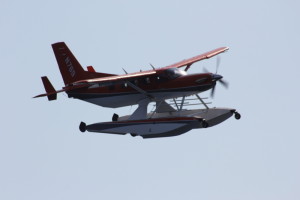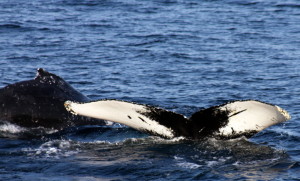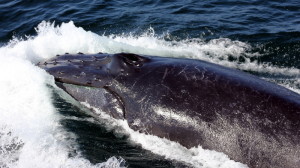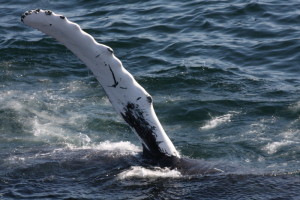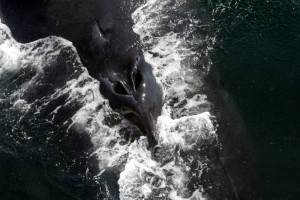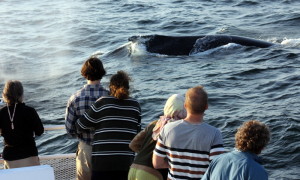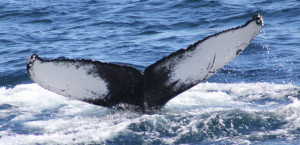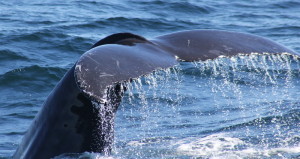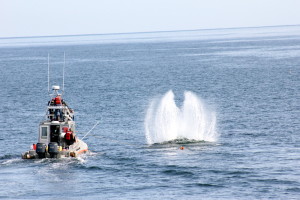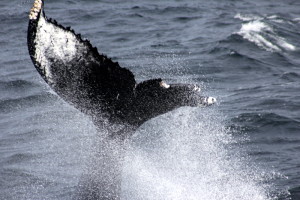September 12 to September 18
September 12 was a calm, sunny day, and as we rounded Race Point, we could see group of 2, 3, and 4 humpback whales scattered as far as the eye could see. Getting a close look at them took patience, though, and we often found ourselves staring up at the sky as we waited for the telltale noise of a whale’s spout to bring our attention back to the water. Luckily, there was a lot to see out there. Birdwatchers were pleased to several species of Shearwater, including the less commonly seen Cory’s and Manx varieties, as well as phalaropes, gannets, and roseate terns. Even for those passengers more interested in mechanical, rather than avian, winged entities had something to write home about as a seaplane, looking like it was prepped for a water landing, flew overhead.
As we spent more time looking, we counted more and more individual humpbacks, uniquely identifiable by the patterns on the undersides of their tails. These observations can really enhance our whale watching experience. For example, we noted that we had seen humpbacks named Seal and Putter, who were born to the same mother, Mars, albeit in different years. Seal was born in 1984 and Putter was born in 1993. They are both males. While there is no evidence of siblings associating with one another more than they would other humpacks, it is no huge surprise to see siblings in the same area. Humpbacks tend to come back to the same area every year, and their calves tend to follow suit.
And while Seal and Putter are now fully grown, we also had a look at some younger individuals. Today, Thumper and her calf were giving us a good look at their flukes. Thumper is a 14 year old animal and this is her second calf. We’ll photograph Thumper’s calf’s fluke as best we can so we can identify this whale when it returns next year without being accompanied by its mom.
Pointing out a humpback named Seal can be confusing, especially when there are actual seals in the area. Today, we were able to get a good luck at a Harbor seal bobbing near the Dolphin IX.
September 13th was another beautiful sunny day with light winds from the Southwest. We passed several Minke whales as we made our way towards Peaked Hill, where we could see spouts from humpbacks as soon as we rounded the corner of Race Point. Reflection and Snare, seen together on a regular basis during the last few days, seemed to not have left each others side. Most of the time, humpback whale associations are short lived, but it is not too uncommon to see longer-term associations of a few days or a few weeks develop. Twine, Bounce, Cantiliver and Pumpkinseed were almost certainly feeding deep. They would dive for long periods of time, but then surface energetically, their mouths full of food.
Samara, another individual humpback, was stole the show that day. Samara was flipper slapping, banging a pectoral fin that exceeds 10 feet in length on the surface of the water, for purposes unknown to scientists.
Samara was rolling and flipper slapping, but was also clearly curious about the boat. This inquisitive whale approached the Dolphin X, and got so close, we were sure she actually nudged the bow!
Sanchal’s energy kept up through September 14th. We started our trip watching Circuit and Ventisca logging at the surface. Logging is a resting behavior that is great for getting good looks at whales. When a humpback logs, it floats at the surface, breathing occasionally, allowing us to see almost is whole body.
After spending some time with these sleepy whales, we decided that we needed more action. We saw some white water to the north and took a chance to head in its direction. What we found was Sanchal, flipper slapping again. This time, this humpback punctuated that behavior with a dramatic breach!
Throughout the day, we witnessed the whole gamut of humpback behaviors, from logging, to breaching to flipper slapping. We even had a repeat visit from Seal, this time very actively tail breaching!
In the afternoon, the gears shifted as we started to see lots of activity at the surface, including bubble feeding. Convict was a particularly active feeder, creating big bubble nets.
It seemed like a new ocean. The wind had picked up, though the seas remained calm. Birds, noticeably absent from the morning’s trip, filling the skies, there to feed on the same fish as the whales. Birders noted Great, Cory’s and Sooty Shearwaters, as well as phalaropes and Northern gannets, dramatically plunge diving after their prey.
September 15th was overcast with a slight drizzle, but the weather didn’t prevent us from having days worth of exciting whale watches. We headed out to Peaked Hill, where we’ve had active whales all week. Sure enough, we could see splashing and spouts from Peaked Hill northwards. We had very close looks at Ventisca and Sanchal who swam right under the bow. This exciting moment was followed by a tail breach from Circuit, and then another one from a whale who we could not identify.
In the afternoon, Spirit and Samara were the highlights of the trip. Aboard the Dolphin X, Samara continued to delight whale watchers, as she had done all week, by breaching and blowing bubbles. Meanwhile, passengers aboard the Dolphin VIII enjoyed even more close approaches, this time by Putter and two others. At one point, Spirit surprised everyone by showing up out of nowhere and breaching right next to us!
The skies cleared up by September 16th and we enjoyed a sunny, warm whale watch off of Peaked Hill. Most of the humpbacks were hanging out by themselves, though some of them were in pairs. We noted that both Ventisca and her 2008 calf, Pleats, were both seen within just a few minutes of each other, though not in association.
Thumper and her calf, not yet a year old, were, not surprisingly keeping close to one another. Her growing calf lingered nearby as Thumper fed by blowing clouds of bubbles. Owl, Pumpkinseed, and Ledge were also seen that day.
Our captain’s finely-tuned awareness of whale behavior really shone on the Dolphin IX today. After watching Samara curiously approach the boat for over 15 minutes, Captain Mark made a prediction. “Look at the huge clump of seaweed,” he said, “I bet if we keep an eye on it, Samara will come up and play with it.”
Samara had just gone on a deep dive right past the seaweed, so we parked and waited. Sure enough, Samara spun around and came back in the opposite direction and Spy-hopped through the seaweed! Even though we can’t always predict what these whales are going to do, 30 + years of intense observation sometimes gives us a little insight in what might interest these animals!
The classy calm waters on September 17th were perfect for observing some things that can only be seen under near-ideal conditions. The 12:00 trip aboard the Dolphin IX was particularly exciting as we came across a pod of about 20 – 25 Common dolphins. Common dolphins, sometimes called Saddlebacks, can be hard to distinguish from their more frequently seen cousins, Atlantic white-sided dolphins. Today, though, it was easy to spot the tell-tale hourglass-shaped pattern along the sides of their bodies. We even noticed a pair of mom/calf pairs in the bunch!
Surely the most exciting part of the day was locating an entangled humpback whale, who we identified as an individual named Goalpost. Again, the calm waters made it easier to spot the fishing gear that appeared to be wrapped around the whale’s head, running through the baleen. This whale was even trailing a lobster buoy! Believe it or not, despite the pervasiveness of entanglements, they can sometimes be very hard to notice, even by the best-trained observer. We immediately called the Provincetown Center for Coastal Studies disentanglement hotline, and within 45 minutes, the R/V Ibis had rounded the bend, ready to attempt a disentanglement. Disentangling a whale can be tricky business, and should only be attempted by professionals. Fortunately, the team was ultimately successful at removing most of the line, hopeful that the whale would shed the rest of the gear on its own, as they often do.
Although our main goal was to keep an eye on the whale until the disentanglement team arrived, that didn’t mean that we didn’t see other exciting things on the way. As we followed Goalpost, a leatherback turtle showed its head! These enormous sea turtles are particularly hard to spot. In fact, it was the first one our naturalist had ever seen around Cape Cod! Finally, we topped off the trip with a sighting of two Mola molas swimming side by side. These enormous ocean sunfish are not often seen together, and we hypothesized that there must have been a lot of food — probably ctenophores or jellies– around that area!
September 18th was dramatically different, and featured high winds and rough seas. That didn’t stop us from venturing out and finding some very active whales off of Peaked Hill. The true highlight of the trip was Music, humpback first seen in 2007. Music was breaching repeatedly, and “conducting”, by slapping its enormous pectoral flippers!
Bayou, a six year old humpback, was also whipping up white water by lobtailing. Nothing like rough seas to kick these whales into high gear!
Birders also got their fair share of excitement with the identification of a dark-morph parasitic jaeger. These birds are often seen harassing terns and other birds to get them to drop their freshly caught fish. An even more an unusual sighting was that of a Great skua. Like the jaeger, these birds will sometimes feed by pirating the catches of other seabirds; however, the skua is much more aggressive, often injuring and even killing its targets!






